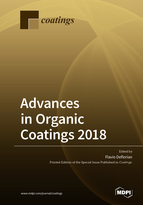Advances in Organic and Polymeric Coatings
A special issue of Coatings (ISSN 2079-6412).
Deadline for manuscript submissions: closed (30 November 2022) | Viewed by 35647
Special Issue Editor
Interests: multifunctional coatings; self-healing; nanotechnology; environmentally friendly coatings; hybrid coatings
Special Issues, Collections and Topics in MDPI journals
Special Issue Information
Dear Colleagues,
The scientific and technological advances in organic coatings have been impressive over the last couple of decades and recent further developments are opening new prospectives for organic coatings science and technology.
New materials, based on nanotechnologies (nanostructured polymeric matrixes, nanopigments), and new surface pretreatments improving the chemical and physical stability of the interfaces, are deeply modifying the performances of organic coatings.
Moreover, organic coatings are more and more multifunctional. In addition to traditional functions, such as corrosion protective actions or aesthetical functions, modern organic coatings must often support additional roles: Antibacterial activity, self healing ability, tribological properties, etc.
The recent advances in experimental techniques (electrochemical methods, optical and electron microscopy, chemical surface analysis, thermal analysis, etc.) applied to organic coatings, provide a powerful tool for research and scientific development in this area.
A further driving force, pulling innovation into the organic coatings area, are environmental issues. In order to develop new systems, joining advanced performance with high environmental sustainability, new materials are under development, anticipating the future legislative requirements.
This frame is inducing to consider the advances in organic coatings (the skin of materials) as one of the most interesting and promising innovation fields in material science.
Prof. Dr. Flavio Deflorian
Guest Editor
Manuscript Submission Information
Manuscripts should be submitted online at www.mdpi.com by registering and logging in to this website. Once you are registered, click here to go to the submission form. Manuscripts can be submitted until the deadline. All submissions that pass pre-check are peer-reviewed. Accepted papers will be published continuously in the journal (as soon as accepted) and will be listed together on the special issue website. Research articles, review articles as well as short communications are invited. For planned papers, a title and short abstract (about 100 words) can be sent to the Editorial Office for announcement on this website.
Submitted manuscripts should not have been published previously, nor be under consideration for publication elsewhere (except conference proceedings papers). All manuscripts are thoroughly refereed through a single-blind peer-review process. A guide for authors and other relevant information for submission of manuscripts is available on the Instructions for Authors page. Coatings is an international peer-reviewed open access monthly journal published by MDPI.
Please visit the Instructions for Authors page before submitting a manuscript. The Article Processing Charge (APC) for publication in this open access journal is 2600 CHF (Swiss Francs). Submitted papers should be well formatted and use good English. Authors may use MDPI's English editing service prior to publication or during author revisions.






